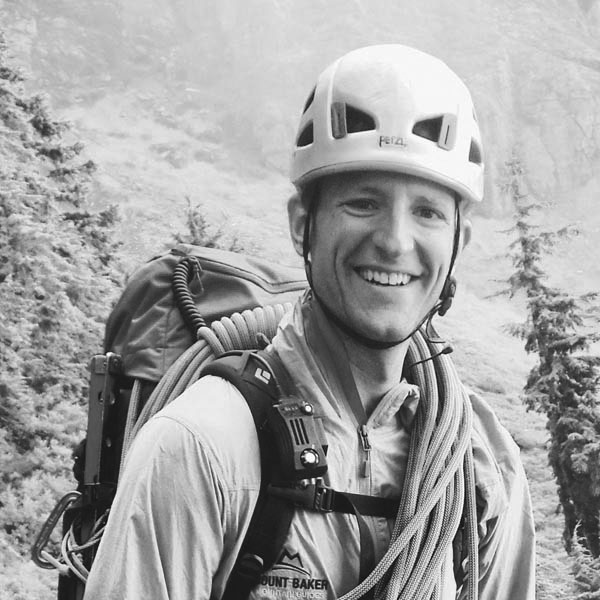Glacier Travel
This last weekend I had the good fortune to summit Mt. Rainier with my wife, Jenni via the Winthrop Glacier – Emmons route. During our descent, I noticed another rope team that had decided to pre-rig chest harnesses so that they would remain upright in the event of a crevasse fall. This made me think a lot about what different types of systems people pre-rig, and more importantly, why.
Standard glacier travel technique involves tying team-mates together a certain distance apart. These distances are based on how wide the crevasses are, and are referred to as “rope intervals.” These rope intervals change depending on where you are in the world, and what kind of crevasse hazard you are dealing with, but typically they range anywhere from 35 ft. to 60 ft. This method of travel is called “long-roping” and its primary purpose is to mitigate crevasse falls.
Once you are set up for glacier travel, you can pre-rig if you choose. “Pre-rig” is simply short for “pre-rigging,” and refers to additional glacier travel systems over and above long roping. Typically, pre-rigs are used to help facilitate crevasse rescue should someone fall in, and include methods to expedite hauling, ascending the rope, etc. Again, what kind of pre-rigging you do depends on what kinds of hazards you are expecting.
Pre-Rigging
Open any glaciated mountaineering “How To” book these days, and you’re bound to see various types of pre-rigs. Take a trip through the mountains and you’ll find that just about everyone has a different idea for how to pre-rig for glacier travel. It appears the point of pre-rigging is being missed. How you pre-rig should reflect the anticipated crevasse fall hazards.
I don’t often pre-rig my rope when climbing in the Cascades. I find that there are simply too many variables to decide which pre-rig to use, and the situation you find yourself in may require a different pre-rig than the one you have set up. However, there are situations where a pre-rig may be useful. There are also some pre-rigs that can’t hurt, and others that need to be used with caution.
I think the most effective pre-rig is simply a prusik tied to the rope in front of the climber, and attached to the belay loop with a locking carabiner, in a non-loading orientation. Basically, this means that if the rope is loaded (like in a crevasse fall) the force transfers directly to the harness without loading the prusik. This pre-rig is the most general, and applies to the most situations. There are countless applications, including rope interval management, crevasse rescue, and fixed line ascension.
I often see Texas Prusiks, or some other form of rope ascension pre-rigged as well. Can’t hurt, that’s for sure. Being able to climb out of a crack is important, especially if your team mates aren’t savvy with crevasse rescue. However, best practice would be to wait until your team mates have constructed an anchor before you begin ascending the rope. This would give you plenty of time to set up your prusiks. My main complaint with pre-rigged ascending systems is that they get in the way if you’re not the one who fell in, and more time is wasted de-rigging and re-rigging the appropriate system.
Finally, to address the climbers on Rainier who pre-rigged with chest harnesses. This system would have the rope tied into the climber’s harness, and then travel up through the chest harness and onto the next climber in front. This isn’t a great idea, and to understand why, let’s make a priority list of hazards. First, chest harnesses are utilized once a climber has fallen into the crack. They help keep the body upright, which can be CRITICAL if the victim is hanging for a long period of time. Typically, they are important when you are carrying an enormous pack and/or there is the possibility that the victim could be knocked unconscious. This is a big “IF.” The problem is that hanging upside down in a crevasse is way down the list of potential hazards, and by pre-rigging chest harnesses, you greatly reduce your ability to arrest a crevasse fall in the first place. Clipping the rope through the chest harness moves the applied force further away from our feet, which are typically the anchor when we self-arrest. This creates a longer lever arm, which applies more load to the rescuers. If we can’t catch a crevasse fall, the pre-rig we choose to use is irrelevant.
However, I’m not saying that you would never pre-rig a chest harness. If you’re carrying large packs, dealing with giant cracks, and you know that the leader is the most likely team member to fall in, then that individual may want to pre-rig with a chest harness. What’s important is that we are thinking critically about the hazards, and attempting to mitigate them with the appropriate techniques.
